Every new project is, in theory, smartly organized and on the path towards a perfect launch, and every nearly completed project is, in reality, a growing pile of work that everyone is rushing to complete in a desperate attempt to keep from missing the launch date by more than a few weeks.
Sound familiar at all? If so, it’s worth giving Spaces a try.
What are Spaces?
When you filter a view on your Shortcut Stories page, you can save that view as a Space, making it easy to return to later and at any time. A Space can be any combination of Projects, Epics, and keyword filters, and is specific to the Workflow it’s created within.
We provide you with a small sampling of Spaces by default, and, here’s the key, allow you to create any number of custom ones yourself.
Watch this video to get a detailed overview:
How can you use Spaces? Let’s take our good friend Bryan as an example. Bryan is a Product Manager for two teams with eight engineers total. These engineers are working on lots of Stories, which makes Bryan’s default view in Shortcut look like the bulletin board at a YMCA that hasn’t been cleared off since the late 80s.
Bryan solved this problem by creating custom Spaces that allow him to target specific segments of Stories that match things he wants to dive into. Bryan has created numerous Spaces, but for the sake of keeping this instructional post to a reasonable length we’ll consider these four:
- Battle Squad Galactica
- The Fellow Squad of the Ring
- Blocked Work
- Needs Documentation
How’d Bryan create all these Spaces, and what exactly does he do with them? Let's find out.
Making Spaces
The act of creating a custom Space is straightforward. Pick a filter (any filter) and then move your mouse pointer right up to the Spaces section to save it. Honestly, the most difficult thing in this part of the process is coming up with a distinctive enough name that you don’t forget about the Space and never click on it again.
Creating a Filter:
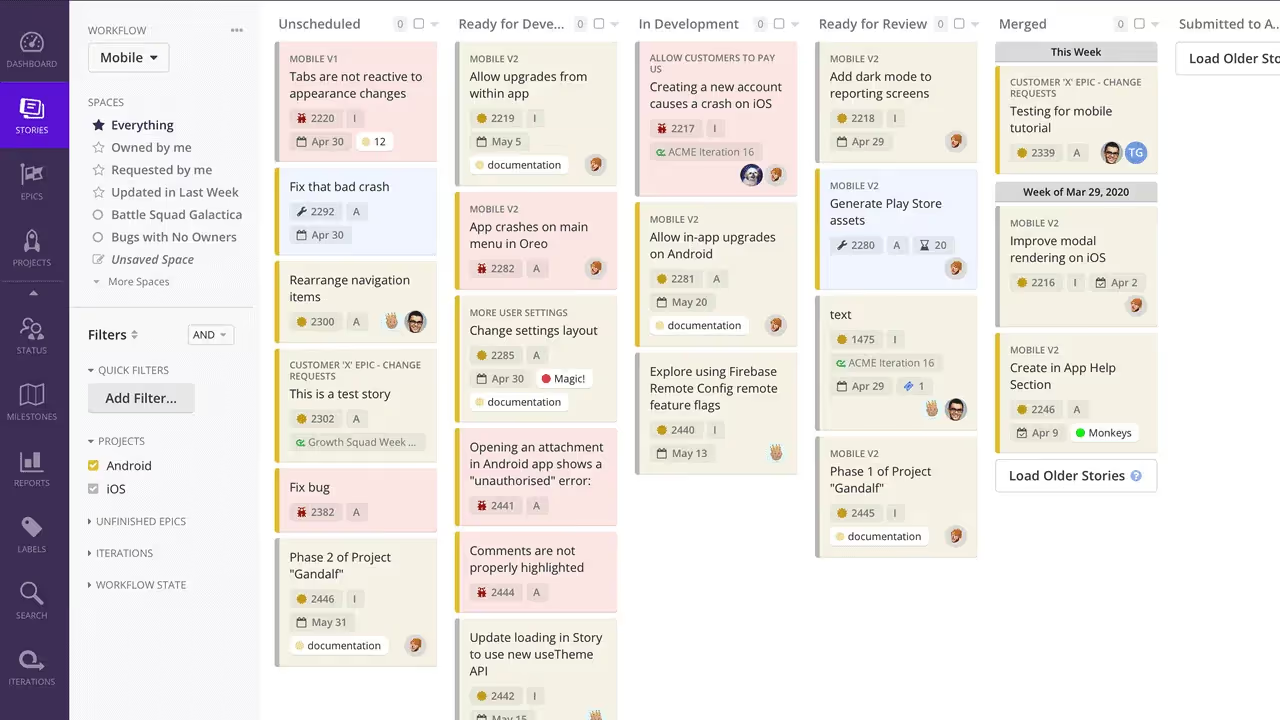
Saving a Space:
.gif)
It’s determining what sort of filtering you want to be doing, and then implementing the necessary filters to get there, that is the more complicated part of building a useful collection of Spaces.
Filtering Groups of People
The two Squads that Bryan acts as Product Manager for are:
- Battle Squad Galactica
- The Fellow Squad of the Ring
He'd like to focus on these individually from time to time and even look into subsections of each. Here’s how we could set this up.
First, we'd find each member of Battle Squad Galactica by typing their names in the Filter and selecting each of them, one at a time.
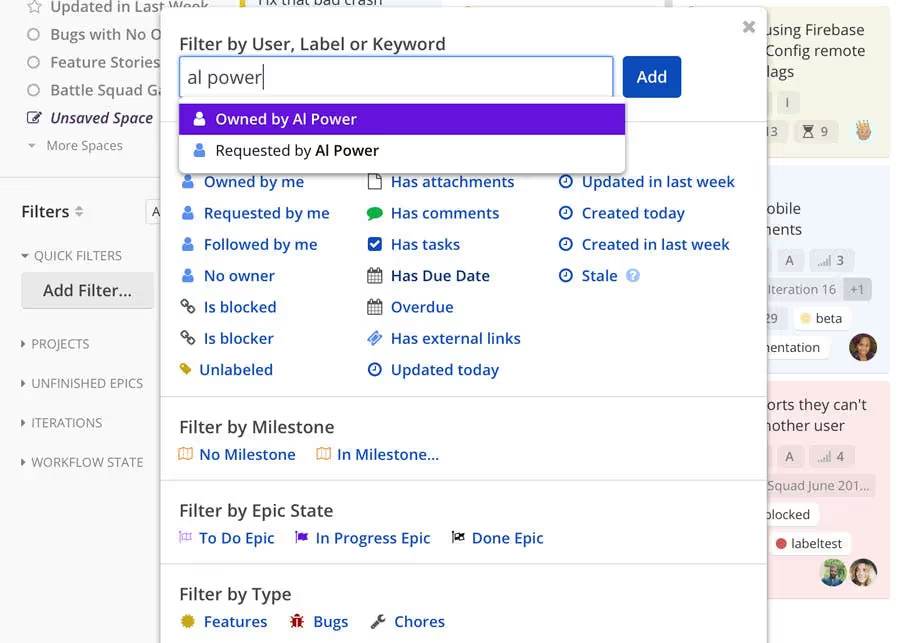
However, simply entering each of their names isn't enough, since, as we can see here, that isn’t returning any results.
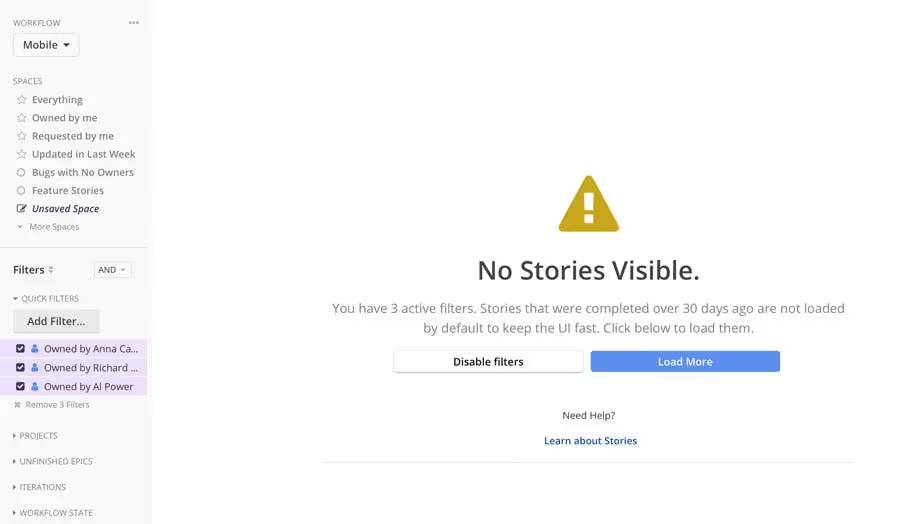
That's because we didn't select OR from the AND / OR drop-down next to the Filter button.
If you use AND filter logic instead of OR in this case, instead of seeing all the Stories in-progress for each individual you’re filtering, you’d instead see only see specific Stories that had were owned by all three people simultaneously. It's certainly possible for a Story to have several owners, but that is much rarer than individual engineers owning specific Stories.
Switching to OR shows us all the Stories owned by any of them, which would include the rarely created Story that might also be owned by ALL of them.

Making this switch immediately shows the Stories owned by all three. So now we can save this Space by moving up to the Unsaved Space slot that magically appeared when we created the Filter.
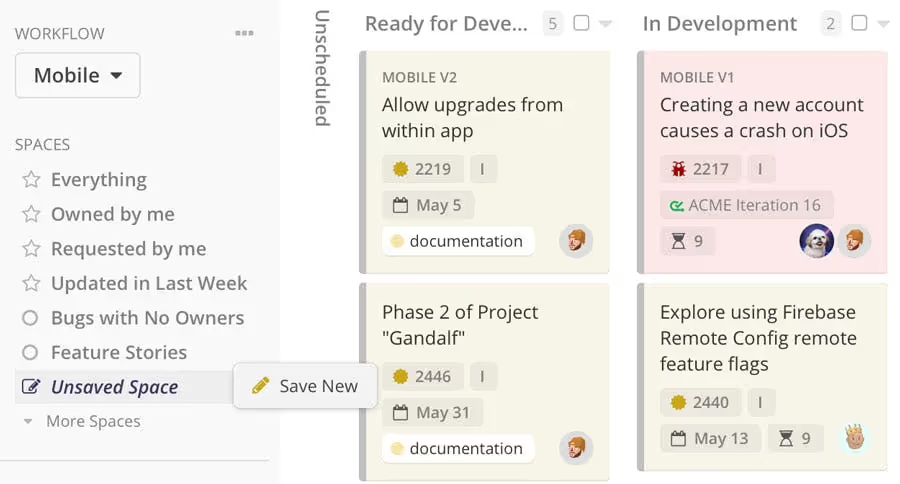
We give it a name and hit enter. All done.
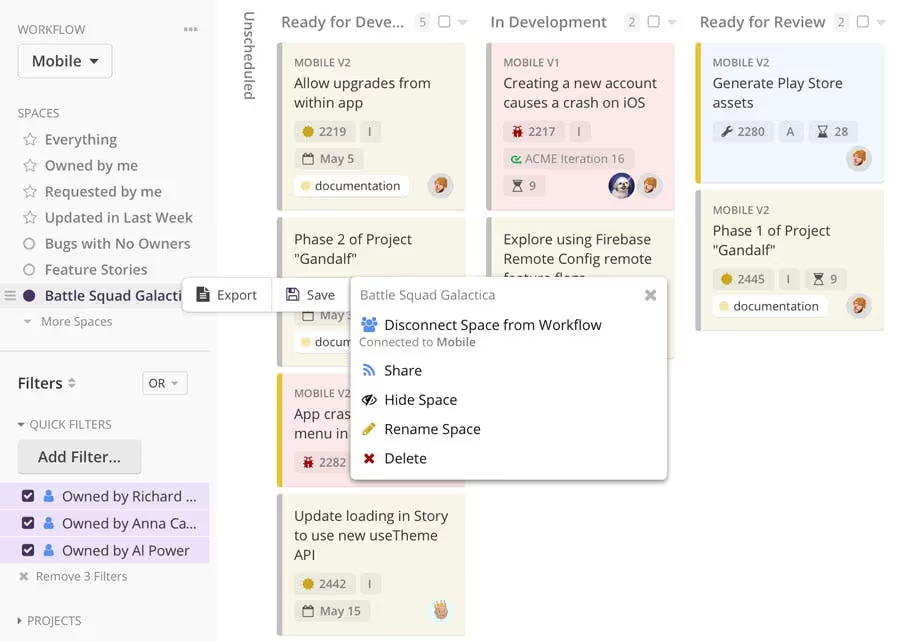
Now this Space can be shared with any one else in your Organization or exported to a CSV to be used outside of Shortcut. And you can create more Groups filtered by people, just as Bryan did with Battle Squad Galactica and the Fellow Squad of the Ring.
Default Spaces provided by Shortcut have a star next to them, custom Stories you've created are marked with a circle, and custom ones you've shared are shown next to a symbol that looks like a wifi symbol that fell on its side.
Let's look at a different example and create a Space that filters based on labels.
Filtering Through Labels
A Story can be marked with any number of Labels, and you can then Filter and create Spaces based on these Labels.
Here's where to assign a Label within a Story:

You can have any number of Labels for all of your stories. Learn more about Labels here.
Point is, you can create Spaces to easily access views based around those Labels. Bryan did that for Stories that would ultimately need to include documentation with a Needs Documentation Space.
To do the same, we return to Add Filter and simply type the name of the Label in the search box. Autocomplete will immediately begin showing all possible matches.
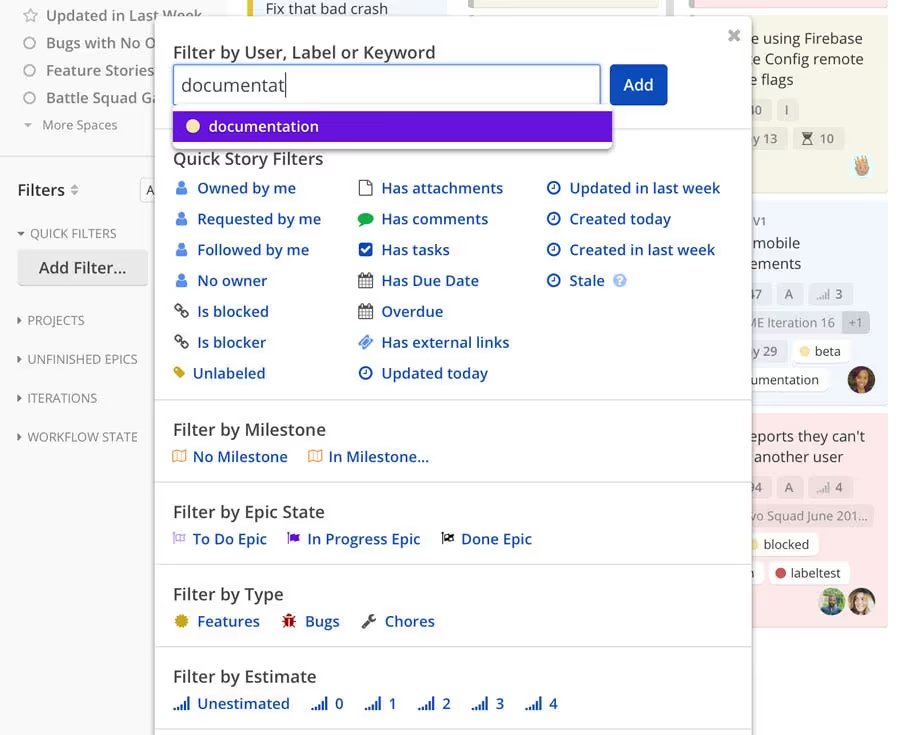
Once selected, you could then use the AND / OR option to add more Labels or other variables to this Space. Or just stick with the one Label as we'll do here and then save it as a Space, like before:

Let's look at another example.
Surfacing Blocked Work
Shortcut provides a couple of ways to mark an in-progress Story as blocked. One way is to create a Label using the method briefly discussed above and then to ensure Software Developers are using the blocked Label whenever they're blocked.
Another even better way is for engineers to use the "is blocked by" option built into every Story.

Select that and then use the Search bar to find the Story that's blocking this one.

Any Story that is noted with a Blocked label or has a "is blocked by" relationship with another Story, can easily be filtered by returning to the Add Filter button and selecting the "Is Blocked" option there.

As with above, you can use the AND / OR option to add other variable to the filter before saving it. Or just go right ahead and save it. Now you have a filter that will show everything currently blocked, and if the Story has a "blocked" relationship with another Story you can zoom in to both of them to see what's going on and help get things unblocked.
One other thing to make note of about Spaces before we close:
Even though all of your Spaces are accessible regardless of which Workflow you're looking at, Spaces are Workflow specific. If you're looking at your Frontend Engineering Workflow and click on a Space you created within your Mobile Workflow, it's going open up your Mobile workflow to allow you to view that Space.
If you have tasks to deal with in multiple Workflows it's worth labeling your Spaces with the name of the Workflows they were created within so you know exactly where you're going when you click on a Space.
By using Spaces, Bryan and his colleagues are able to focus on exactly the Stories they want to look at and avoid being overwhelmed by the sheer amount of work that's going on at any given moment. This makes it easier to move initiatives forward and complete them. Which is, of course, the primary reason to use product management software like Shortcut.
If you have questions about using Spaces, visit our community and ask away. Or visit help.clubhouse.io to search our documentation or contact Support. We're here to help. And also to product manage. But mostly to help.




















